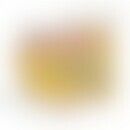Synonym(s)
HistoryThis section has been translated automatically.
Nakamura, 1977
DefinitionThis section has been translated automatically.
Stripy dermatitis (see also flagellant dermatitis) after eating the edible mushroom shiitake (Lentinus edodes). Auricularia auricula-judae, the Judas ear, a beta-glucan-containing saprophytic fungus from the class of agaricomycetes, can also cause similar clinical symptoms.
You might also be interested in
Occurrence/EpidemiologyThis section has been translated automatically.
EtiopathogenesisThis section has been translated automatically.
Lentinan, a (thermolabile! water-soluble) polysaccharide from Lentinus edodes, which is also used for tumor therapy in Japan, is assumed to be the triggering agent. Dermatitis has also been described here. It is probably a toxic reaction. Apparently, more type IV reactions are detected than type I reactions. In mushroom growers with allergic contact dermatitis, positive immediate reactions were triggered in prick tests (Wagner G 2011).
LocalizationThis section has been translated automatically.
neck, trunk (see picture), extremities, rare face
ClinicThis section has been translated automatically.
Hours after eating a dish containing shiitake, appearance of streaky, flagellate-like, very itchy erythema, which is answered with violent scratching reactions. Streaky, parallel, persistent erythema develops in the scratch marks, which develop into correspondingly arranged papulo-vesicles. Skin symptoms persist for weeks. They heal without post-inflammatory hyperpigmentation. Also fever, diarrhea and mucosal ulcers.
HistologyThis section has been translated automatically.
Differential diagnosisThis section has been translated automatically.
Melanodermia factitia (skin changes due to bleomycin)
External therapyThis section has been translated automatically.
Internal therapyThis section has been translated automatically.
Systemic antihistamines, such as desloratadine 5 mg p.o. once a day or levocetirizine 5 mg p.o. once a day. For highly acute courses, short-term systemic glucocorticoids such as prednisolone (Decortin H) initially 100-150 mg/day p.o., phasing out within a week.
Note(s)This section has been translated automatically.
The shiitake mushroom is the second most common cultivated mushroom in the world, is similar in taste to the porcini mushroom and is used fresh, steamed or dried, especially in Asian cuisine. Its cap grows up to 20 cm wide and is brown-grey to brown in color with pressed, triangular scales. Its lamellae are white-brownish, the spores colorless.
LiteratureThis section has been translated automatically.
- Haas N et al (2001) Shiitake dermatitis. Dermatologist 52: 132-135
- Hiernickel C et al. (2015) Shiitake dermatitis: an impressive case report. Dermatologist 66: 455-456
- Lang N (2016) Streaky, whiplash-like erythema and succulent papules: flagellate dermatitis after consumption of Auricularia auricula-judae. JDDG 14: 303-304
- Nakamura T (1977) Toxicoderma caused by shiitake (Lentinus edodes) in Japan. Jpn Clin Dermatol 31: 65-68
- Wagner G et al. (2011) Shiitake dermatitis. Linear grouped erythema and papules on the upper trunkand décolleté. J Dtsch Dermatol Ges 9: 555-557.
- https://www.bfr.bund.de/cm/343/gesundheitliches_risiko_von_shiitake_pilzen.pdf
- Levy AM et al. (1998) Eosinophilia and gastrointestinal symptoms after ingestion of shiitake mushrooms. J Allergy Clin Immunol. ;101(5):613-20. doi: 10.1016/S0091-6749(98)70168-X. PMID: 9600497.
- Nguyen AH et al. (2017) Clinical features of shiitake dermatitis: a systematic review. Int J Dermatol ;56(6):610-616. doi: 10.1111/ijd.13433. Epub 2017 Jan 4. PMID: 28054338.
Outgoing links (5)
Desloratadine; Flagellant dermatitis; Glucorticosteroids topical; Levocetirizine; Shiitake;Disclaimer
Please ask your physician for a reliable diagnosis. This website is only meant as a reference.






